
Report On the State
of the Environment In China
2 0 0 3
Marine Environment
![]() General Situation
General Situation
In 2003, the Grade II marine area was 80,000 km2, which was 31,000 km2 less than the previous year; the Grade III marine area was 22,000 km2, which was 3000 km2 more than the previous year; the Grade IV marine area was 15,000 km2, which was 3,000 km2 less than the previous year; the marine area which was worse than Grade IV was 25,000 km2, which was 1,000 km2 less than the previous year; and the rest of the marine area was Grade I. The overall pollution trend was somewhat curbed.
In 2003, pollution in the offshore areas was alleviated to some extent. Among the 237 points monitored in the offshore areas, Grade I and II accounted for 50.2%, which was 0.5% more than the previous year; and Grade IV and worse accounted for 30%, which was 5.9% less than the previous year.
The main pollutants in China's offshore areas were: inorganic nitrogen and activated phosphates; the amount of petroleum, lead, and COD in some areas; and soluble oxygen, copper, and mercury in a few areas exceeded the standard.
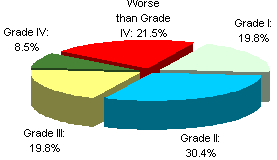
Water Quality of China's Offshore Areas
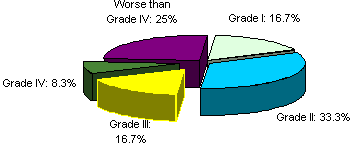
Water Quality of Bohai Sea

Water Quality of the Yellow Sea
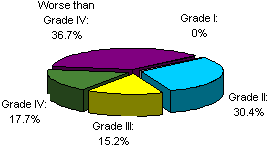
Water Quality of the East China Sea

Water Quality of the South China Sea
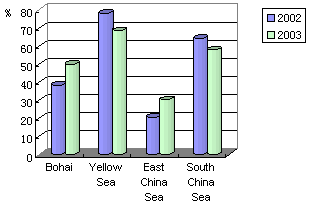
Comparison of Sea Area attaining Grade I or Grade II standards in 2002 and
2003
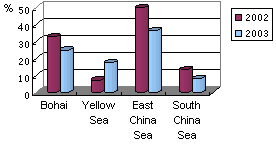
Comparison of Sea Area that was worse than Grade IV in 2002 and 2003
The Water Quality of the Four Major Seas:
The water quality of the Yellow Sea and the South China Sea was generally good. Grade I and Grade II areas accounted for 68.7% and 57.9% respectively in these two seas, which were 9.5% and 6.5% respectively lower than the previous year. The water quality of Bohai Sea improved to some extent. Grade I and Grade II areas accounted for 50% of the Bohai Sea, which was 11.9% higher than the previous year. The water quality of the East China Sea was poor. No area of the East China Sea qualified for Grade I, and only 30.4% qualified for Grade II.
The Offshore Areas of Coastal Provinces, Autonomous Regions, and Municipalities:
The water quality of the offshore areas of Guangxi and Hainan was good. Grade I and Grade II seawater accounted for more than 70%. The water quality of the offshore areas of Tianjin, Zhejiang, and Jiangsu was poor. The water quality of the offshore areas of Shanghai was very poor.

Water Quality of the Offshore Areas of Costal Provinces, Autonomous Regions, and Municipalities
Red Tides: In 2003, red tides happened 119 times, affecting a total area of 14,550 km2. Among
them, 36 red tides happened within the "Red Tide Monitored Areas", and affected a total area of
1,500 km2.
The main characteristics of the red tides in 2003 were: long duration and concentrated seasons of
occurrence. Red tides happened in all the twelve months of the year. In the Yellow Sea and the
Bohai Sea, red tides mainly happened in summer, and especially in July and August. In the East
China Sea, red tides happened from late spring till late autumn, and especially between May and
September. In the South China Sea, red tides happened in all four seasons, but mostly between May
and September. In the river mouth area of the Yangtze River and the offshore areas of Zhenjiang,
red tides happened nearly 40 times between mid-April and early July; and they usually lasted for
a long time, with the longest duration being 35 days.
Red tides were of greater scale and were concentrated in certain areas. In all the seas, red
tides that covered more than 100 km2 happened 27 times. Among these, red tides that covered more
than 500 km2 happened 8 times. Most large-scale red tides were concentrated in the river mouth
area of the Yangtze River and the offshore areas of Zhejiang, with a total covered area of 10,000
km2. The number of red tides and the covered area in these two regions accounted for 72% and 89%
respectively of those for all sea area.
Hazardous and harmful algae have increased: In the Yellow Sea and the Bohai Sea, red tide
algae were mostly Noctiluca scintillans, Chattonella marina, and Heterosigma akashiwo that are
harmful to fish. In the river mouth area of the Yangtze River and the offshore areas of Zhejiang,
red tide algae were mostly Prorocentrum triestinum before late June and were mostly Skeletonema
costatum after June. In the offshore areas of Fujian and Guangdong, the occurrence time of red
tides was more scattered and the red tides covered less area, but there were many kinds of
harmful algae, such as Alexandrium sp, Karenia mikimotoi, Dinophysis fortii, Chattonella marina,
Heterosigma akashiwo, and Phaeocystis globosa.
![]() Countermeasures and Actions:
Countermeasures and Actions:
The "Phosphorus Ban" was consolidated: So far, four provinces off the Bohai Sea have
banned phosphorus in all the offshore areas. The phosphorus content in municipal wastewater has
been dramatically reduced.
Construction of key engineering projects has made progress: During the 10th Five-Year
Period, 286 construction projects were planned for the four provinces neighboring the Bohai Sea,
with a required investment of RMB 29.67 billion. By the end of 2003, 88 projects (31% of all
planned projects) had been completed, 104 projects (36%) were in progress, and 94 projects (32%)
were to be kicked off. The completed investment was RMB 12.03 billion, which was 41% of the total
planned investment. Among that, the government investment was 1.5 billion, 12.5% of the completed
investment. Over 60% of all planned projects in the four provinces had been completed or started
in any of these four provinces. 86.8% of all planned projects in Hebei Province had been
completed or started. Among the projects that had been completed, there were 21 wastewater
treatment plants (23.6% of the total projects), with a treatment capacity of 896,000 tons per day
(which is 13.6% of all the planned capacity).
Weekly Reports on the Water Quality of Swimming Beaches in Summer: Between June and
September of 2003, the State Environmental Protection Administration conducted seawater quality
monitoring for swimming beaches in key coastal cities, and promulgated 17 issues of Weekly Report
on the Water Quality of Swimming Beaches.
Construction of Marine Protection Zones: By the end of 2003, China had established more
than 80 marine nature reserves. Among them, 24 were national-level marine nature reserves. The
establishment of these nature reserves helps protect the coasts, river mouths and islands that
have high scientific, academic, and historic values, protect rare and endangered marine animals
(such as Chinese white-flag dolphin, striped seal, dugong, green turtle, and lancelet) and their
habitats, and protect typical marine systems such as mangrove, coral reefs, and coastal wetlands.